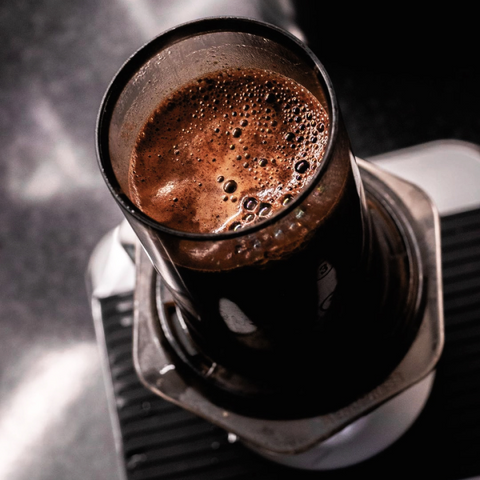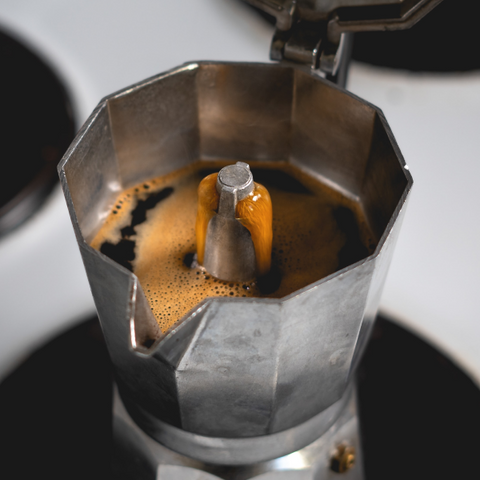When the afternoon slump hits, the craving for a pick-me-up can be undeniable. Enter espresso—a rich, flavorful, and energizing base for many coffee beverages, from cortados to lattes.
And here’s something else that’s sure to pick you up: If you’re trying to limit your spending at the corner coffeeshop (and you don’t want to shell out for an espresso machine), you can learn how to make espresso at home without a machine.
While only an espresso machine can make true espresso, you don't necessarily need this coffee shop tool to enjoy a delicious shot of an espresso-like beverage. Below, we’re breaking down 4 methods for how to make espresso coffee drinks without a machine.
1. AeroPress

If you’re an on-the-go coffee drinker, you may already be familiar with an AeroPress. These devices are small plastic cylinders that create coffee in mere minutes with a piston-style brewer. [1] By pressing the piston, hot water is forced through the ground coffee beans and a thin paper filter, creating a quick and high-flavor cup of coffee.
The Step-by-Step Process
If asked how to make espresso without a machine, you may not guess an AeroPress. However, these devices can create an espresso-like concoction in very little time.
Brew your AeroPress espresso at home with these steps: [2]
- Start by boiling water, and let it cool for about a minute to reach a temperature of around 175°F. This slightly lower temperature (compared to traditional espresso brewing) is recommended to prevent over-extraction and excessive bitterness.
- Grind about 3 tablespoons of your chosen espresso coffee beans to a fine grind.
- Place a paper filter inside the AeroPress cap or basket, and rinse it with hot water. This step eliminates any papery taste and preheats the device.
- Attach the cap to the brewing chamber and place it on top of your coffee cup. The cup is there to catch the brewed espresso, so don’t forget it!
- Add your finely ground coffee to the chamber, tapping the grounds down lightly for an even press.
- Pour a small amount of hot water into the AeroPress—just enough to wet the coffee grounds. Wait 30 to 45 seconds for the water to soak in, then stir the mixture a few times. This step is called"blooming" and ensures the grounds get even saturation.
- Add hot water to the AeroPress cylinder between the 1.5 to 2-inch mark. Insert the plunger on top but do not press down. Let the coffee grounds steep for 1 to 2 minutes for desired flavor and intensity.
- After steeping, press the plunger into the AeroPress chamber steadily and with gentle pressure.
- Once the espresso is extracted, remove the Aeropress, unscrew the cap, and release any grounds into a compost or garbage bin. Then, enjoy your espresso!
2. French Press

Say bonjour to the French press—a classic coffee brewing method that can be adapted to create a concentrated espresso-like brew. The French press is a tall carafe with a long pressable metal filter that pushes water through the ground beans. [1] Typically, this creates a rich cup of coffee with a heavy mouthfeel.
The Step-by-Step Process
When learning how to make an espresso at home without a machine, the French press is your best friend. Thanks to its pressing method and intense flavor, this device can create a rich espresso drink that’s quite close to the real thing. The best part? You can also get more than one espresso out of a single batch.
Follow these steps to learn how to use a french press to create your intense espresso brew:
- Start by grinding your coffee beans to a medium-fine consistency, similar to that used for espresso. While most French presses require semi-fine grounds for making coffee, a fine grind will produce a more espresso-like drink.
- Preheat your French press by rinsing it with hot water. This will help maintain the optimal coffee brewing temperature.
- Add the ground coffee to the French press—about 1 tablespoon of grounds for every 4 ounces of water. Adjust the measurements based on your taste and intensity preferences (the more grounds per water, the more intense the flavor).
- Boil water until it reaches around 200°F, and pour it into the French Press carafe until it’s about halfway full.
- Give the grounds and water a gentle stir, ensuring all the grounds are fully saturated with water.
- Place the metal plunger or press on top of the carafe but do not press it down. Let the coffee grounds steep for 3 to 4 minutes.
- After the steeping, slowly press down the plunger to separate the coffee grounds from the liquid.
- Pour the concentrated coffee into an espresso cup, and voila! You can sit back, sip, and enjoy your homemade French press espresso!
3. Moka Pot

Hailing from Italy, the Moka Pot is a stovetop coffee maker that has been a staple in European households for decades. The double-chamber device looks like a mini metal coffee pourer. It utilizes steam pressure to extract the bold flavors and intense aromas that espresso lovers crave. [3] Thanks to its intense extraction, this device is a great substitute for brewing espresso at home.
The Step-by-Step Process
Similar to the French press, a Moka Pot can create multiple ounces of “espresso” with one brew. To achieve that rich and robust flavor, follow these steps to discover how to use a moka pot to make an espresso drink: [3]
- Grind your chosen coffee beans into medium-fine grounds.
- Remove the top chamber of the Moka Pot. Fill the lower chamber with hot (not boiling) water right up to the safety valve.
- Insert the filter basket into the lower chamber of the Moka Pot. This is where the coffee grounds will go, so make sure the basket sits securely.
- Add the coffee grounds into the filter basket without packing them down. Screw on the top chamber of the Moka Pot tightly to ensure a proper seal (this is where the brewed coffee will collect).
- Place the Moka Pot on a stovetop burner over medium heat. As the heat creates steam, the pressure from the steam will force hot water through the coffee grounds to extract flavor.
- When you start to hear a gurgling or hissing sound, turn off the heat and remove the Moka Pot from the stove. This sound signals that coffee has risen in the top changer and is finished brewing. The process usually takes about 3 to 5 minutes.
- Place the Moka Pot on a cool surface or run the bottom chamber under cold water (just be careful to avoid spilling any coffee out of the top chamber).
- Allow the Moka Pot to sit for a moment. This helps remove any residual pressure that could create a “burst” or “pop” when opening the top chamber.
- Carefully unscrew the top chamber, and pour the brewed coffee into espresso cups. Then, savor the concentrated coffee that’s nearly identical to espresso with a few friends (or save the others for later).
4. Portable Espresso Maker

You no longer have to choose between your precious morning time and your precious morning espresso. These trusty and compact companions can create espresso-style coffee anywhere, anytime. Portable espresso makers can vary in design, but most use intense pressure through manual pumping, spring-loaded systems, or compressed air cartridges to create a near-identical drink to espresso. [4]
The Step-by-Step Process
Since portable espresso makers are designed to create espresso coffee-like drinks, they usually come with specific instructions. However, for most devices, you can also follow these general steps:
- Start by preparing your portable espresso maker according to the manufacturer's instructions. This may include cleaning, attaching or detaching parts, or adding batteries.
- Grind your coffee beans to a fine consistency, similar to what you would use for traditional espresso.
- Add the coffee grounds into the designated compartment or filter basket of your portable espresso maker, ensuring the amount fits the instructions given.
- Heat water separately to the appropriate temperature range recommended by the manufacturer.
- Fill the water chamber of your portable espresso maker with the hot water up to its designated point.
- Secure any other necessary chambers or filters onto the machine, ensuring everything is tightly sealed and in place.
- Begin the brewing process as instructed by the manufacturer. This may involve pumping, pressing a button, or operating a lever to create the intense pressure needed to extract the coffee.
- Depending on the model, the brewing time can vary. Double-check the manufacturer’s instructions to ensure proper brewing.
- Once the brewing process is complete, carefully pour the freshly brewed espresso into your favorite cup. If your device has a built-in cup, enjoy it from there!
Sip and Savor Your Favorite Espresso Drinks with Trade Coffee
When learning how to make an espresso without a machine, you might realize you already have the tools to brew coffee at home. After all, who needs a fancy espresso machine when you can use a French press, Moka Pot, or other device to get that intense, rich, and robust flavor? Just get a little creative with your home coffee maker, and you can whip up a cappuccino or cortado in no time.
Another important factor in making delicious espresso at home? The coffee bean. If you’re interested in finding the right acidity, intensity, and flavor for your home espresso, consider taking our coffee quiz.
Once you’ve found your perfect espresso brew, subscribe to your favorite blends so that your espresso cup is never empty. At Trade, we are here to help you dial in your daily espresso go-to. Explore our online coffee subscriptions and get back to brewing today!
Sources:
- Handground. The Ultimate Brew Down: Aeropress vs. French Press. https://handground.com/grind/ultimate-brew-down-aeropress-vs-french-press
- AeroPress. AeroPress & Espresso. https://aeropress.com/blogs/aeropress-recipes/aeropress-espresso
- Serious Eats. The Moka Pot Is an Inexpensive Espresso Alternative. https://www.seriouseats.com/moka-pot-cheap-espresso-alternative
- Wired. 5 Best Portable Espresso Makers (2022). https://www.wired.com/story/best-portable-espresso-makers/









